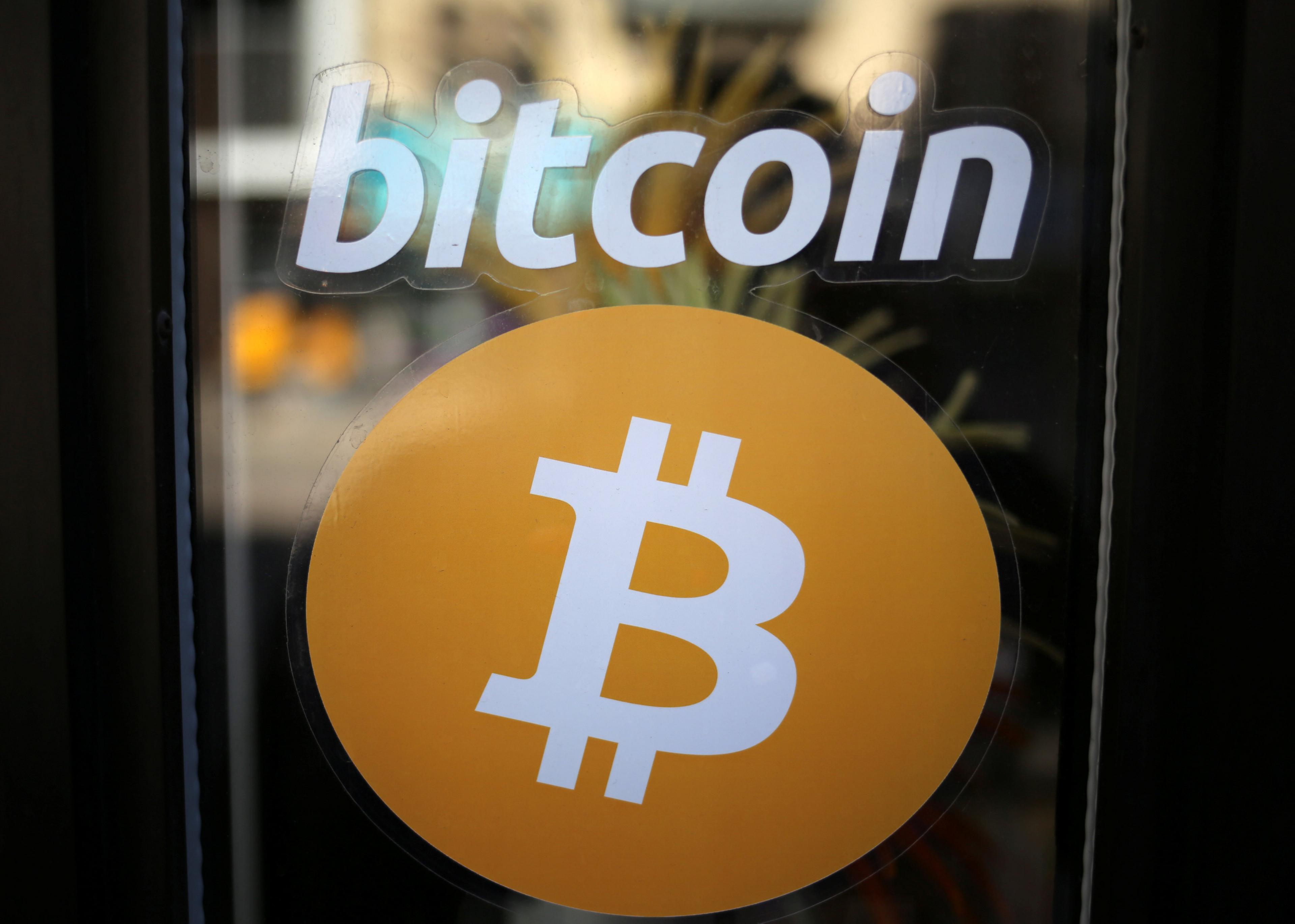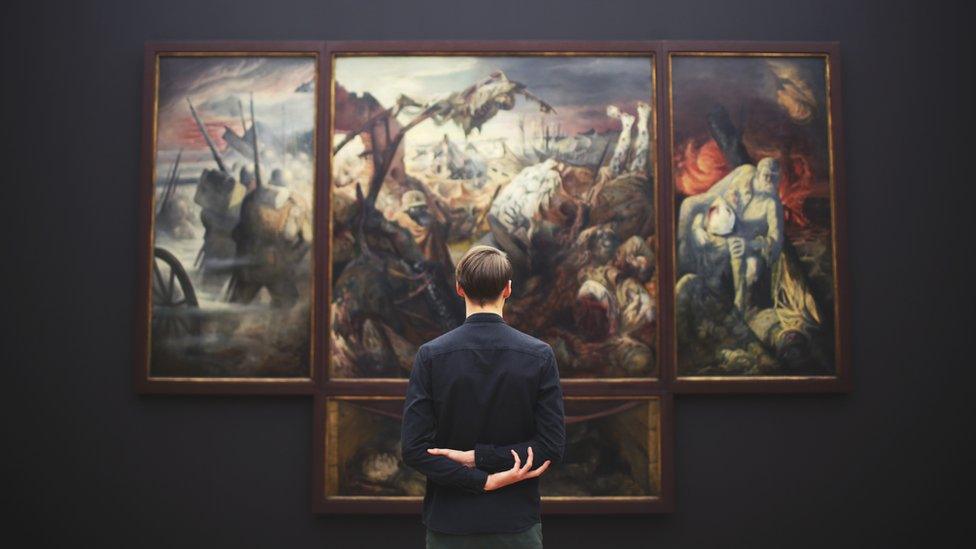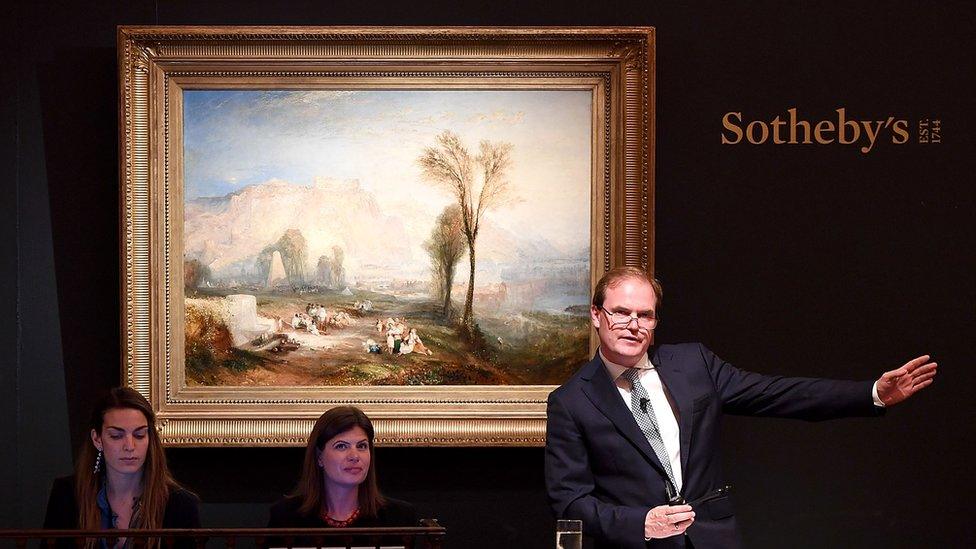How Bitcoin is infiltrating the $60bn global art market
- Published
"Accepting crypto-currencies broadens my client base," says Eleesa Dadiani
Why is the art world getting excited about digital currency Bitcoin and its underlying technology blockchain?
Eleesa Dadiani owns and runs an art gallery in London's famous Cork Street. She was born in Georgia in the Caucasus and was "breastfed by gypsies".
But she is also a passionate believer in the power of Bitcoin and other digital currencies.
When we meet she is busy preparing for an exhibition of sculptures made from the exhausts of former Formula 1 racing cars.
One of these strange rib-cage-like creations made from the super-strong alloy inconel has been gold-plated and will sell for about £35,000.
"These are pieces of history," she tells me.
In a first for the tradition-bound art world of Cork Street, her international clientele will have the opportunity to pay using Bitcoin, the digital cryptocurrency underpinned by blockchain technology.
The gallery will also accept other cryptocurrencies such as Ethereum, Ethereum Classic, Dash, Litecoin, and soon, Monero, she says.
Why?

The number of retailers that accept Bitcoin is rising, but it is still relatively small
"This is not a demand-driven decision at all, it's intuitive based on the way things are going," she says.
She believes paying by cryptocurrency will become as normal as paying by cash or credit card. She also hopes it will attract a new, non-traditional type of art investor.
Blockchain, the underlying technology, is a digital ledger or record of transactions that is distributed across, and verified by, thousands of computers in a network.
Once the network has reached a consensus that a transaction has happened, the ledger is updated and cannot be tampered with.
"Blockchain is a borderless, open source, decentralised peer-to-peer network that governments cannot shut down," she says. "For me, the blockchain is going to be the biggest thing since the internet."

More Technology of Business


And the fact that there is no centralised body - like a bank head office, for example - makes cryptocurrencies safer, she argues, despite their reputation for being volatile, high-risk and the favourite "store of value" for criminals and hackers.
Bitcoin payments can be anonymous and potentially beyond the grasp of tax authorities, but this isn't the reason she's offering payment by cryptocurrency, she assures me.
So how easy is it to accept a Bitcoin payment?
"It's really very simple," she explains. "I give the client my public key [a long string of letters and numbers] and they use that to send bitcoin to my account from their digital wallet or bitcoin exchange," she says.
"My wallet is linked to my personal bank so I can then convert those bitcoins into pounds, euros or dollars."
Ms Dadiani is such a fan of cryptocurrencies - she trades in them as well - that she is launching her own version, Dadicoin, later this year.

Have you ever fancied owning an Old Master painting? Now you can, or a share of one at least...
The $60bn art world in general is warming to the potential of cryptocurrencies, partly because of blockchain's dual ability to establish the provenance of works of art and thereby reduce the reliance on brokers and other middlemen.
Marcelo Garcia Casil, for example, is chief executive and co-founder of Maecenas, an online marketplace that will enable art owners to sell shares in their expensive works of art (worth more than $1m) and raise money far more cheaply than they could though a bank.
And the owners also get to keep possession of their artworks while sharing up to 49% of the ownership.
Investors, who ordinarily wouldn't be able to afford multi-million-dollar works of art, will be able buy shares or units in the work using cryptocurrency. They will then be able to sell these units later in the marketplace. Each transaction is recorded cryptographically on the Ethereum blockchain.
"We want to make fine art accessible for everyone," says Mr Casil, who was born in Argentina, now lives in Singapore, and has a background in investment banking.
"The old auction houses like Christie's and Sotheby's have controlled the art market for centuries, so we think the opportunity for disruption is huge."
Establishing the authenticity of works of art is critical to their value, and this will still need to be done by skilled professionals, admits Mr Casil.
"But once the provenance has been recorded in the blockchain, you never have to do it again," he says. This takes a lot of cost out of the system.

The Maecenas marketplace will give investors a chance to buy shares in fine art
Maecenas has already attracted works of art worth $100m (£77m; 86m euros) in total, says Mr Casil, and the marketplace is due for launch in September.
The art world has been flirting with Bitcoin for a few years now, despite the likes of auction house Sotheby's saying they have no plans to accept the currency.
In April 2015, the Austrian Museum of Applied Art/Contemporary Art (MAK) was the first museum in the world to buy a work of art using Bitcoin.
Dutch artist Harm van den Dorpel created a limited-edition screensaver that was cryptographically authenticated through blockchain.
And online gallery Cointemporary exhibits digital artworks by international contemporary artists that can only be bought with Bitcoin. Purchases are handled by Coinbase, a leading cryptocurrency exchange.

Venerable art auction house Sotheby's says it has no plans to accept Bitcoin
Blockchain establishes the chain of ownership, preventing anyone from stealing or tampering with the work.
But will Bitcoin and other cryptocurrencies ever really become a mainstream alternative to traditional money?
Views differ widely.
In Japan, there is a big move to equip 260,000 retail locations with bitcoin capability, and a few high-street retailers, such as Lush, have opted to accept the currency.
But Joe Pindar, a director at cyber-security company Gemalto, says: "At present there are very few businesses accepting bitcoin as a payment method - less than 1% of all retailers.
"The biggest barrier to adoption is the length of time it takes to settle a payment in person, with transactions taking tens of minutes.
Despite this, Mr Pindar says several large retailers have been experimenting with the cryptocurrency, but may choose "to adopt bitcoin for online purchases only, where time to process a payment is less important."
The currency's volatility is an issue - the value of one bitcoin topped $3,000 in June, before crashing to below $1,900 in July - and transactions are taking longer and longer to process.
This is largely to do with the rules governing how Bitcoin works, and there is currently a big row over how the issue should be resolved.
It could be that blockchain proves to be more important to the art world than its flashier Bitcoin offspring.
Follow Matthew Wall on Twitter, external and Facebook, external